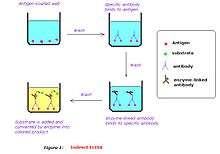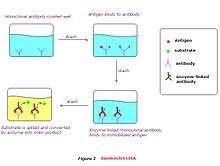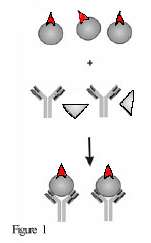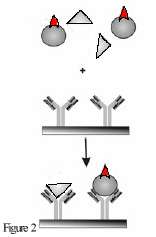Structural Biochemistry/Proteins/Enzyme-Linked Immunoabsorbent Assay (ELISA)
< Structural Biochemistry < ProteinsGeneral Information
Enzyme-linked Immunoabsorbent Assay (ELISA) is an analytical method utilizing various antibodies to detect the presence of a compound in a wet or liquid sample. Enzyme linked to the antibodies react with substrates to produce a color change, signifying the presence of desired substance, usually antigen. The intensity of the color can be used to determine the concentration of substance of interest in a sample. Antibodies are assayed to form a pure line of monoclonal antibodies that only detect the desired antigen or protein.
If the antibody-labeled enzyme is specific to another antibody, the indirect ELISA method is used whereas if the antibody-labeled enzyme can directly react with the antigen, sandwich method is preferred.
Indirect ELISA

- Purpose: Detect the presence of a type of antigen.
- Procedure
- Coat sample well with antigen.
- Add sample to coated well. If antibody of interest (Antibody A) is present in the sample, it will bind to the antigen. Wash out the remaining sample.
- Add a second antibody (Antibody B) to the sample. Antibody B is an antibody that will specifically bind to antibody A and is linked to a special enzyme. Wash out the remaining antibody B.
- Substrate is added to the mixture. This substrate will trigger a reaction with enzyme attached to antibody B to produce colored substance.
- The rate at which the color changes is proportional to the amount of antigen in the solution.
- Usage: HIV Infection Test
Sandwich ELISA

In the Sandwich ElISA, or two site capture assay, two different antibodies are used. The wells are coated with an antibody specific for one region of the antigen, then the test solution containing antigen is added. Following washing, the second antibody, which recognizes a different epitope of the antigen, will be added. This antibody will have the enzyme attach.
- Purpose: Detect the presence of a type of antigen.
- Procedure
- Coat sample well with monoclonal antibody (Antibody Z) that responds specifically to one type of antigen.
- Add sample that might contain the antigen of interest (Antigen C) to the coated sample well. If sample contains Antigen C, it will bind to antibody Z. Wash out the remaining sample.
- Add a second monoclonal antibody (Antibody Y), which also binds to Antigen C, to the well. This antibody is linked to a special enzyme.
- Substrate, which reacts with enzymes on Antibody Y, is added. Reaction occurs and color change is observed.
- Presence of colored product confirms the presence of Antigen C. The intensity of the colored product can be used to determine the concentration of Antigen C. Also the rate of color change of the solution is proportional to the amount of antigen present.
- Application of sandwich ELISA: Pregnancy tests
In the pregnancy test, the reaction zone will contain the primary antibody (usually a monoclonal mouse antibody IgG) that recognizes a portion of a unique beta chain of the pregnancy hormone called Human Chorionic Gonadotropin (HCG). The secondary antibody conjugated with enzyme in the test zone recognizes the alpha chain. This chain can be found in luteinizing hormone (LH) which also present in non-pregnant women. It will display a color change in this test zone if the antigen was bound to both antibodies forming a sandwich. At last, a control zone contains antibody that binds to primary antibody (anti-IgG). A color change in this zone will show that our test was correctly preformed.
Competitive ELISA


Competitive ELISA is another method of ELISA that involves competitive binding process.
- Procedure
- Incubate unlabeled antibody within presence of its antigen.
- Bound antibody/antigens are added to a antigen coated well.
- Wash and remove unbound antibodies.
- Competition results from the fact that the more antigens are present in the sample, the less antibody will be able to bind.
- A secondary antibody that is coupled to a enzyme is added.
- Substrate added for signal
- The weaker colored or fluorescent signal that is released shows that that the original antigen concentration was high.
Reverse ELISA
Reverse ELISA is a relatively new technique specifically created to investigate the West Nile virus envelope protein and how it is able to detect virus-specific antibodies. This newer technique uses an solid phase made up of an immunosorbent polystyrene rod with ogives. The entire device is immersed in a test tube containing the collected sample and the following usual steps such as washing, incubation in conjugate and incubation in chromogenous are performed through dipping the micro-wells with the prepared sample concentration.
The advantage of Reverse ELISA over other ELISA techniques is how sensitive the test can detect different reagents, which is beneficial for detecting different kinds of antibodies with their respective antigens with large target assays. The sample volume can be increased to improve the test sensitivity in clinical (saliva, urine), food (bulk milk, pooled eggs) and environmental (water) samples. One ogive is left unsensitized to measure the non-specific reactions of the sample. The use of laboratory supplies for dispensing sample aliquots, washing solution and reagents in microwells is not required, facilitating ready-to-use lab-kits and on-site kits. Based on the platform of ELISA, this method uses an antibody microarray to capture native antigens. Autoantibody reactivity is then evaluated by differentially labeling patient IgG and incubating these antibodies with the native antigens that are immobilized on the antibody microarray.
- Procedure
- Preparation: Prepare autoantibodies (IgG) separated and purified from serum. Label them either through radioactive tagging or a fluorescent dye.
- Extraction: Label autoantibodies with native protein on array. Native antigens bound to antibodies on array are extracted from microarray with unique monoclonal antibodies. Array should be incubated with native protein extracts such as cells, tissue, or body fluid, etc.
- Analysis: Analyze concentration based on intensity of dye appearing in the assay. When the process is complete, the assay is then evaluated by its intensity of color which is determined for each well. The amount of color produced correalates to the amount of primary antibody bound to the proteins on the bottom of the microwells